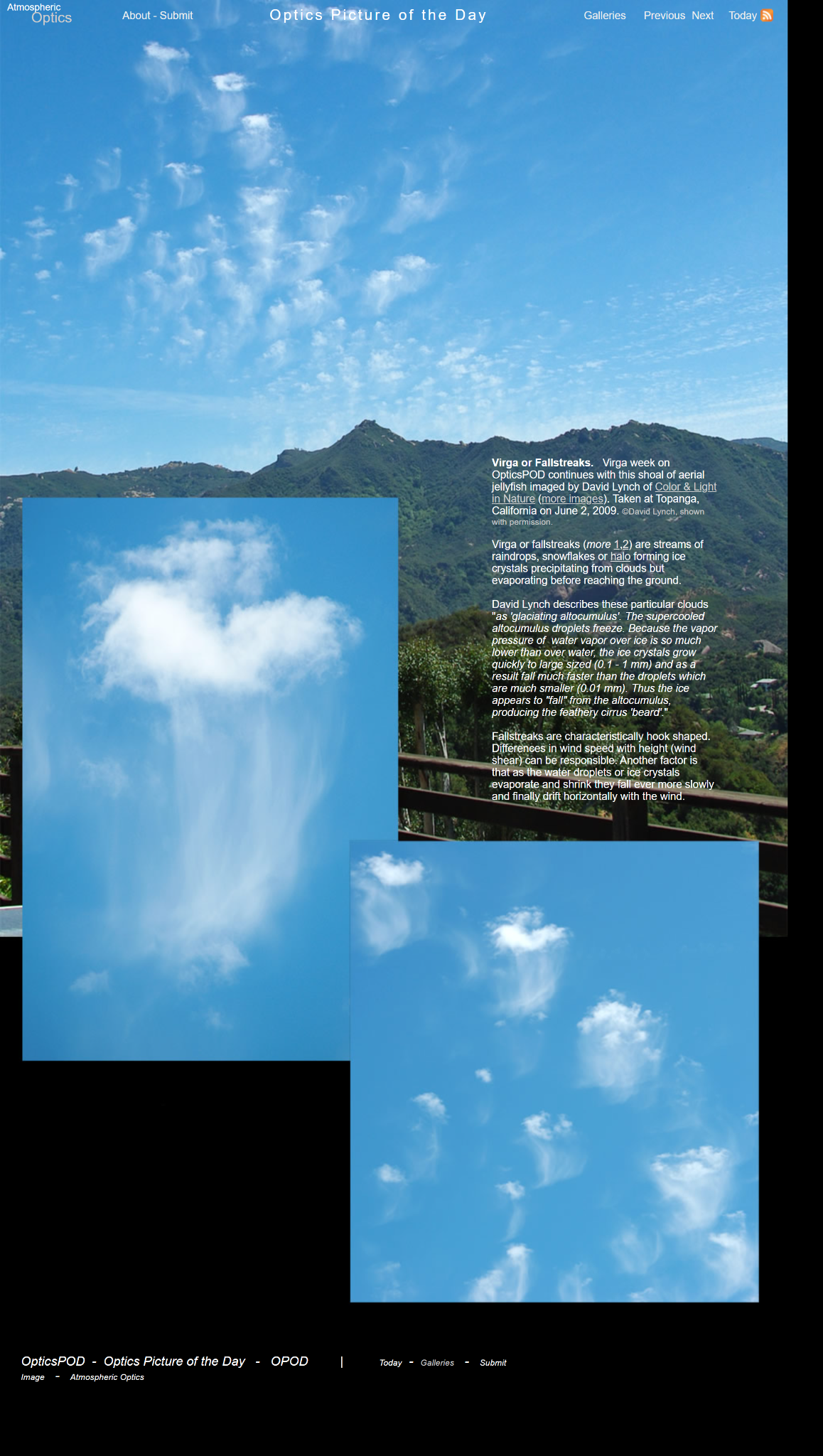Virga, fallstreaks
Virga, Fallstreaks: A Phenomenon of Aerial Jellyfish
Have you ever looked up at the sky and noticed long, wispy trails of precipitation that seem to disappear before reaching the ground? These ethereal formations are known as virga or fallstreaks. They are mesmerizing phenomena that occur when raindrops, snowflakes, or ice crystals precipitate from clouds but evaporate before making contact with the Earth's surface.
One remarkable example of virga was captured by David Lynch of Color & Light in Nature. In his photograph taken in Topanga, California on June 2, 2009, he immortalized a shoal of aerial jellyfish suspended in the sky. These peculiar clouds, referred to as "glaciating altocumulus" by Lynch, exhibit a unique process that gives rise to the formation of fallstreaks.
The altocumulus droplets within these clouds are supercooled, meaning they exist in a liquid state below the freezing point. As the temperature drops further, these droplets freeze into ice crystals. What makes this process fascinating is that the vapor pressure of water over ice is significantly lower than over liquid water. Consequently, the ice crystals grow rapidly, reaching sizes ranging from 0.1 to 1 mm. Due to their larger size and increased weight, they fall much faster than the smaller droplets, which measure around 0.01 mm. This creates the illusion of ice "falling" from the altocumulus clouds and forming a delicate cirrus-like "beard."
The distinctive hook shape often observed in fallstreaks can be attributed to wind shear, which refers to the variation in wind speed with height. This atmospheric condition can cause the precipitation trails to curve and take on intriguing formations. Another contributing factor to their unique appearance is the gradual evaporation and shrinkage of water droplets or ice crystals as they descend. As these particles become smaller, they experience reduced drag and fall more slowly, eventually drifting horizontally with the wind.
Virga and fallstreaks are captivating natural phenomena that remind us of the complexity and beauty of our atmosphere. While they may appear delicate and transient, their formation involves intricate processes that highlight the interplay between temperature, pressure, and wind patterns in the sky.
In conclusion, the presence of virga and fallstreaks adds an enchanting touch to our atmospheric optics. These ethereal trails of precipitation, often resembling aerial jellyfish, arise when raindrops, snowflakes, or ice crystals descend from clouds but evaporate before reaching the ground. The interplay between supercooled droplets, freezing temperatures, wind shear, and evaporation gives rise to their unique shapes and patterns. Next time you gaze up at the sky, keep an eye out for these mesmerizing formations and appreciate the wondrous complexity of our atmosphere.

Virga or Fallstreaks. Virga week on OpticsPOD continues with this shoal of aerial jellyfish imaged by David Lynch of Color & Light in Nature (more images). Taken at Topanga, California on June 2, 2009. ©David Lynch, shown with permission.
Virga or fallstreaks (more 1,2) are streams of raindrops, snowflakes or halo forming ice crystals precipitating from clouds but evaporating before reaching the ground.
David Lynch describes these particular clouds "as 'glaciating altocumulus'. The supercooled altocumulus droplets freeze. Because the vapor pressure of water vapor over ice is so much lower than over water, the ice crystals grow quickly to large sized (0.1 - 1 mm) and as a result fall much faster than the droplets which are much smaller (0.01 mm). Thus the ice appears to "fall" from the altocumulus, producing the feathery cirrus 'beard'."
Fallstreaks are characteristically hook shaped. Differences in wind speed with height (wind shear) can be responsible. Another factor is that as the water droplets or ice crystals evaporate and shrink they fall ever more slowly and finally drift horizontally with the wind.
Note: this article has been automatically converted from the old site and may not appear as intended. You can find the original article here.
Reference Atmospheric Optics
If you use any of the definitions, information, or data presented on Atmospheric Optics, please copy the link or reference below to properly credit us as the reference source. Thank you!
-
<a href="https://atoptics.co.uk/blog/virga-fallstreaks-2/">Virga, fallstreaks</a>
-
"Virga, fallstreaks". Atmospheric Optics. Accessed on December 21, 2024. https://atoptics.co.uk/blog/virga-fallstreaks-2/.
-
"Virga, fallstreaks". Atmospheric Optics, https://atoptics.co.uk/blog/virga-fallstreaks-2/. Accessed 21 December, 2024
-
Virga, fallstreaks. Atmospheric Optics. Retrieved from https://atoptics.co.uk/blog/virga-fallstreaks-2/.